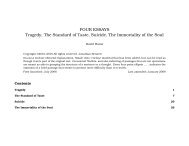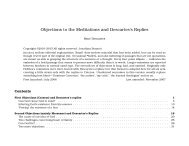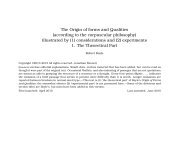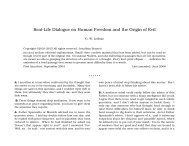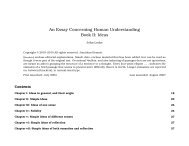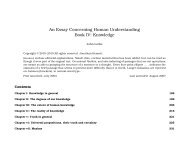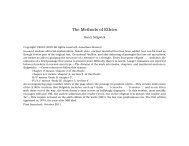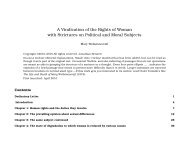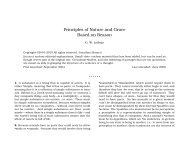The Form and Principles of the Sensible and Intelligible World
The Form and Principles of the Sensible and Intelligible World
The Form and Principles of the Sensible and Intelligible World
You also want an ePaper? Increase the reach of your titles
YUMPU automatically turns print PDFs into web optimized ePapers that Google loves.
<strong>The</strong> <strong>Sensible</strong> <strong>and</strong> <strong>Intelligible</strong> <strong>World</strong> Immanuel Kant III: <strong>The</strong> form <strong>of</strong> <strong>the</strong> sensible world<br />
single great big item that we ought to call Space·—so that it<br />
embraces absolutely all outer sensible things, which means<br />
that it<br />
how <strong>the</strong> sentence ends: principium constituit universitatis,<br />
h.e. totius quod non potest esse pars alterius.<br />
conservatively translated: constitutes a principle <strong>of</strong> universality,<br />
i.e. <strong>of</strong> a whole that can’t be a part <strong>of</strong> ano<strong>the</strong>r whole.<br />
<strong>and</strong> meaning something like this: acts as <strong>the</strong> source <strong>of</strong><br />
wholeness, i.e. brings it about that <strong>the</strong>re is such a thing<br />
as <strong>the</strong> external world, <strong>the</strong> assemblage <strong>of</strong> external things that<br />
isn’t a part <strong>of</strong> any o<strong>the</strong>r assemblage.<br />
[See <strong>the</strong> explanation <strong>of</strong> ‘world’ at <strong>the</strong> start <strong>of</strong> this work.]<br />
Corollary<br />
<strong>The</strong>se, <strong>the</strong>n, are <strong>the</strong> two principles <strong>of</strong> sensitive knowledge;<br />
<strong>the</strong>y aren’t general •concepts such as come into play in<br />
intellectual matters, but singular •intuitions whose status<br />
as intuitions doesn’t stop <strong>the</strong>m from being pure. <strong>The</strong> laws<br />
<strong>of</strong> reason ·in intellectual matters· teach that what makes a<br />
composite thing possible are its parts, especially its simple<br />
parts; but when we move across from intellectual matters<br />
to sensitive intuition, <strong>the</strong> story changes: it is <strong>the</strong> infinite<br />
whole that makes possible each thinkable part, right down<br />
to <strong>the</strong> simple ones (which aren’t parts but limits). To mark<br />
<strong>of</strong>f any definite space or time by assigning its limits you<br />
have to start with infinite space <strong>and</strong> infinite time within<br />
which <strong>the</strong> smaller spaces or times are marked <strong>of</strong>f. And <strong>the</strong><br />
markers—<strong>the</strong> point <strong>and</strong> <strong>the</strong> instant—are conceivable only as<br />
limits within a space <strong>and</strong> time that is already given. So all<br />
<strong>the</strong> basic properties <strong>of</strong> <strong>the</strong>se concepts lie outside <strong>the</strong> domain<br />
<strong>of</strong> reason <strong>and</strong> <strong>the</strong>refore can’t be explained in intellectual<br />
terms. Still, <strong>the</strong>y are what <strong>the</strong> intellect works with when with<br />
perfect confidence it uses logical laws to draw conclusions<br />
from primary data <strong>of</strong> intuition.<br />
15<br />
. . . .·<strong>The</strong> concept <strong>of</strong>· space is applied as an image to <strong>the</strong><br />
concept <strong>of</strong> time, representing time by a line <strong>and</strong> its limits<br />
(instants) by points. Time. . . .embraces with its own relations<br />
absolutely all things—space itself <strong>and</strong> ·<strong>the</strong> whole contents<br />
<strong>of</strong> space·; <strong>and</strong> also thoughts, which aren’t spatially related<br />
to anything. Although time doesn’t dictate laws to reason, it<br />
does create <strong>the</strong> conditions in which <strong>the</strong> mind can inter-relate<br />
its own notions in accordance with <strong>the</strong> laws <strong>of</strong> reason. To<br />
judge that something is impossible, I have to see that it<br />
predicates both A <strong>and</strong> not-A <strong>of</strong> <strong>the</strong> same subject at <strong>the</strong><br />
same time. And—above all—if we’re applying our intellect to<br />
experience, we need time-relations to help us determine what<br />
is earlier <strong>and</strong> what later, <strong>and</strong> thus what causes <strong>and</strong> what is<br />
caused; <strong>and</strong> to do that for external causes <strong>and</strong> effects we also<br />
need spatial relations. And we can’t have any thoughts about<br />
spatial quantities—·distances, areas, volumes, etc.·—unless<br />
we do it by applying numbers to some chosen unit. And<br />
numbers exist only because <strong>the</strong>re are aggregates that are<br />
distinctly known by enumeration, i.e. by successively adding<br />
one to one—a process that happens in time.<br />
A question that arises insistently for everyone is this: Is<br />
<strong>the</strong> concept <strong>of</strong> space (time) •born with us or •acquired. <strong>The</strong><br />
answer ‘acquired’ seems to have refuted by <strong>the</strong> things I have<br />
demonstrated; but let us not casually opt for ‘born with us’,<br />
because that opens up a path towards <strong>the</strong> lazy philosophy<br />
that keeps saying ’It’s no use exploring fur<strong>the</strong>r’. And, anyway,<br />
<strong>the</strong> concepts <strong>of</strong> space <strong>and</strong> time certainly have been acquired,<br />
not by<br />
•abstraction from <strong>the</strong> sensing <strong>of</strong> objects (for sensation<br />
gives <strong>the</strong> •matter <strong>and</strong> not <strong>the</strong> •form <strong>of</strong> human knowledge),<br />
but<br />
•from <strong>the</strong> mind’s action <strong>of</strong> co-ordinating its sensa<br />
according to permanent laws.<br />
Each <strong>of</strong> <strong>the</strong>se two concepts is like a fixed plan or diagram




